Physiological Response of Nutrient-Stressed Lemna gibba to Pulse Colloidal Silver Treatment
Abstract
1. Introduction
2. Results
2.1. The Effects of Total Nitrogen and Phosphorus Nutrition on Duckweed’s Growth Rate
2.2. Photosynthetic Pigment Content
2.3. Biomarkers of Oxidative Stress
2.4. Antioxidative Response
2.4.1. Antioxidative Enzyme Activities
2.4.2. Non-Enzymatic Antioxidants and Free Radical Scavenging Activity
3. Discussion
4. Materials and Methods
4.1. Duckweed Lemna gibba
4.2. Experimental Design
4.3. Photosynthetic Pigment Content
4.4. Biomarkers of Oxidative Stress
4.5. Antioxidative Response
4.5.1. Protein Extraction and Antioxidant Enzyme Activity Assay
4.5.2. Ascorbic Acid Concentration, Soluble Phenolic Compound Concentration, and Free Radical Scavenging Activity
4.6. Data Analysis
5. Conclusions
Author Contributions
Funding
Data Availability Statement
Conflicts of Interest
References
- Ceschin, S.; Crescenzi, M.; Iannelli, M.A. Phytoremediation Potential of the Duckweeds Lemna minuta and Lemna minor to Remove Nutrients from Treated Waters. Environ. Sci. Pollut. Res. 2020, 27, 15806–15814. [Google Scholar] [CrossRef]
- Häder, D.P.; Banaszak, A.T.; Villafañe, V.E.; Narvarte, M.A.; González, R.A.; Helbling, E.W. Anthropogenic Pollution of Aquatic Ecosystems: Emerging Problems with Global Implications. Sci. Total Environ. 2020, 713, 136586. [Google Scholar] [CrossRef] [PubMed]
- Bashir, I.; Lone, F.A.; Bhat, R.A.; Mir, S.A.; Dar, Z.A.; Dar, S.A. Concerns and Threats of Contamination on Aquatic Ecosystems. In Bioremediation and Biotechnology: Sustainable Approaches to Pollution Degradation; Springer Nature Switzerland AG.: Cham, Germany, 2020; pp. 1–26. [Google Scholar] [CrossRef]
- Hampel, M.; Blasco, J.; Segner, H. Molecular and Cellular Effects of Contamination in Aquatic Ecosystems. Environ. Sci. Pollut. Res. 2015, 22, 17261–17266. [Google Scholar] [CrossRef]
- Fulton, B.A.; Brain, R.A.; Usenko, S.; Back, J.A.; King, R.S.; Brooks, B.W. Influence of Nitrogen and Phosphorus Concentrations and Ratios on Lemna gibba Growth Responses to Triclosan in Laboratory and Stream Mesocosm Experiments. Environ. Toxicol. Chem. 2009, 28, 2610–2621. [Google Scholar] [CrossRef]
- Rogers, K.R.; Navratilova, J.; Stefaniak, A.; Bowers, L.; Knepp, A.K.; Al-Abed, S.R.; Potter, P.; Gitipour, A.; Radwan, I.; Nelson, C.; et al. Characterization of Engineered Nanoparticles in Commercially Available Spray Disinfectant Products Advertised to Contain Colloidal Silver. Sci. Total Environ. 2018, 1375–1384. [Google Scholar] [CrossRef]
- Cascio, C.; Geiss, O.; Franchini, F.; Ojea-Jimenez, I.; Rossi, F.; Gilliland, D.; Calzolai, L. Detection, Quantification and Derivation of Number Size Distribution of Silver Nanoparticles in Antimicrobial Consumer Products. J. Anal. At. Spectrom. 2015, 30, 1255–1265. [Google Scholar] [CrossRef]
- Lim, J.-H.; Bairi, V.G.; Linder, S.W.; Fong, A. Detection and Characterization of Silver Nanostructures in Consumer Products. J. Nanosci. Nanotechnol. 2019, 19, 8078–8087. [Google Scholar] [CrossRef] [PubMed]
- Wasukan, N.; Srisung, S.; Kulthong, K.; Boonrungsiman, S.; Maniratanachote, R. Determination of Silver in Personal Care Nanoproducts and Effects on Dermal Exposure. J. Nanoparticle Res. 2015, 17, 425. [Google Scholar] [CrossRef]
- Zhang, W.; Xiao, B.; Fang, T. Chemical Transformation of Silver Nanoparticles in Aquatic Environments: Mechanism, Morphology and Toxicity. Chemosphere 2018, 191, 324–334. [Google Scholar] [CrossRef] [PubMed]
- Gottschalk, F.; Sonderer, T.; Scholz, R.W.; Nowack, B. Modeled Environmental Concentrations of Engineered Nanomaterials (TiO2, ZnO, Ag, CNT, Fullerenes) for Different Regions. Environ. Sci. Technol. 2009, 43, 9216–9222. [Google Scholar] [CrossRef]
- Zhang, W.; Ke, S.; Sun, C.; Xu, X.; Chen, J.; Yao, L. Fate and Toxicity of Silver Nanoparticles in Freshwater from Laboratory to Realistic Environments: A Review. Environ. Sci. Pollut. Res. 2019, 26, 7390–7404. [Google Scholar] [CrossRef]
- Pem, B.; Ćurlin, M.; Jurašin, D.D.; Vrček, V.; Barbir, R.; Micek, V.; Fratila, R.M.; de la Fuente, J.M.; Vrček, I.V. Fate and Transformation of Silver Nanoparticles in Different Biological Conditions. Beilstein J. Nanotechnol. 2021, 12, 665–679. [Google Scholar] [CrossRef]
- Angel, B.M.; Goodwyn, K.; Jolley, D.F.; Simpson, S.L. The Use of Time-Averaged Concentrations of Metals to Predict the Toxicity of Pulsed Complex Effluent Exposures to a Freshwater Alga. Environ. Pollut. 2018, 238, 607–616. [Google Scholar] [CrossRef]
- Angel, B.M.; Simpson, S.L.; Granger, E.; Goodwyn, K.; Jolley, D.F. Time-Averaged Concentrations Are Effective for Predicting Chronic Toxicity of Varying Copper Pulse Exposures for Two Freshwater Green Algae Species. Environ. Pollut. 2017, 230, 787–797. [Google Scholar] [CrossRef]
- Belgers, J.D.M.; Aalderink, G.H.; Arts, G.H.P.; Brock, T.C.M. Can Time-Weighted Average Concentrations Be Used to Assess the Risks of Metsulfuron-Methyl to Myriophyllum spicatum under Different Time-Variable Exposure Regimes? Chemosphere 2011, 85, 1017–1025. [Google Scholar] [CrossRef] [PubMed]
- Razinger, J.; Dermastia, M.; Drinovec, L.; Drobne, D.; Zrimec, A.; Dolenc Koce, J. Antioxidative Responses of Duckweed (Lemna minor L.) to Short-Term Copper Exposure. Environ. Sci. Pollut. Res. Int. 2007, 14, 194–201. [Google Scholar] [CrossRef] [PubMed]
- Begović, L.; Mlinarić, S.; Antunović Dunić, J.; Katanić, Z.; Lončarić, Z.; Lepeduš, H.; Cesar, V. Response of Lemna minor L. to Short-Term Cobalt Exposure: The Effect on Photosynthetic Electron Transport Chain and Induction of Oxidative Damage. Aquat. Toxicol. 2016, 175, 117–126. [Google Scholar] [CrossRef]
- Razinger, J.; Dermastia, M.; Koce, J.D.; Zrimec, A. Oxidative Stress in Duckweed (Lemna minor L.) Caused by Short-Term Cadmium Exposure. Environ. Pollut. 2008, 153, 687–694. [Google Scholar] [CrossRef] [PubMed]
- Roubeau Dumont, E.; Larue, C.; Pujol, B.; Lamaze, T.; Elger, A. Environmental Variations Mediate Duckweed (Lemna minor L.) Sensitivity to Copper Exposure through Phenotypic Plasticity. Environ. Sci. Pollut. Res. 2019, 26, 14106–14115. [Google Scholar] [CrossRef]
- Yang, J.; Li, G.; Xia, M.; Chen, Y.; Chen, Y.; Kumar, S.; Sun, Z.; Li, X.; Zhao, X.; Hou, H. Combined Effects of Temperature and Nutrients on the Toxicity of Cadmium in Duckweed (Lemna aequinoctialis). J. Hazard. Mater. 2022, 432, 128646. [Google Scholar] [CrossRef]
- Leblebici, Z.; Aksoy, A. Growth and Lead Accumulation Capacity of Lemna Minor and Spirodela polyrhiza (Lemnaceae): Interactions with Nutrient Enrichment. Water Air Soil Pollut. 2011, 214, 175–184. [Google Scholar] [CrossRef]
- Yu, H.; Qi, W.; Cao, X.; Wang, Y.; Li, Y.; Xu, Y.; Zhang, X.; Peng, J.; Qu, J. Impact of Microplastics on the Foraging, Photosynthesis and Digestive Systems of Submerged Carnivorous Macrophytes under Low and High Nutrient Concentrations. Environ. Pollut. 2022, 292, 118220. [Google Scholar] [CrossRef] [PubMed]
- Lemon, G.D.; Posluszny, U.; Husband, B.C. Potential and Realized Rates of Vegetative Reproduction in Spirodela polyrhiza, Lemna minor, and Wolffia borealis. Aquat. Bot. 2001, 70, 79–87. [Google Scholar] [CrossRef]
- van Hoeck, A.; Horemans, N.; Monsieurs, P.; Cao, H.X.; Vandenhove, H.; Blust, R. The First Draft Genome of the Aquatic Model Plant Lemna minor Opens the Route for Future Stress Physiology Research and Biotechnological Applications. Biotechnol. Biofuels 2015, 8, 188. [Google Scholar] [CrossRef]
- Rozman, U.; Kalčíková, G. The Response of Duckweed Lemna minor to Microplastics and Its Potential Use as a Bioindicator of Microplastic Pollution. Plants 2022, 11, 2953. [Google Scholar] [CrossRef]
- Varga, M.; Horvatić, J.; Barišić, L.; Lončarić, Z.; Dutour Sikirić, M.; Erceg, I.; Kočić, A.; Štolfa Čamagajevac, I. Physiological and Biochemical Effect of Silver on the Aquatic Plant Lemna gibba L.: Evaluation of Commercially Available Product Containing Colloidal Silver. Aquat. Toxicol. 2019, 207, 52–62. [Google Scholar] [CrossRef]
- Tripathi, A.; Liu, S.; Singh, P.K.; Kumar, N.; Pandey, A.C.; Tripathi, D.K.; Chauhan, D.K.; Sahi, S. Differential Phytotoxic Responses of Silver Nitrate (AgNO3) and Silver Nanoparticle (AgNPs) in Cucumis sativus L. Plant Gene 2017, 11, 255–264. [Google Scholar] [CrossRef]
- la Point, T.W.; Waller, W.T. Field Assessments in Conjunction with Whole Effluent Toxicity Testing. Environ. Toxicol. Chem. 2000, 19, 14–24. [Google Scholar] [CrossRef]
- Hazeem, L.J.; Kuku, G.; Dewailly, E.; Slomianny, C.; Barras, A.; Hamdi, A.; Boukherroub, R.; Culha, M.; Bououdina, M. Toxicity Effect of Silver Nanoparticles on Photosynthetic Pigment Content, Growth, ROS Production and Ultrastructural Changes of Microalgae Chlorella vulgaris. Nanomaterials 2019, 9, 914. [Google Scholar] [CrossRef] [PubMed]
- Jiang, H.S.; Li, M.; Chang, F.Y.; Li, W.; Yin, L.Y. Physiological Analysis of Silver Nanoparticles and AgNO3 Toxicity to Spirodela polyrhiza. Environ. Toxicol. Chem. 2012, 31, 1880–1886. [Google Scholar] [CrossRef]
- Ksiązyk, M.; Asztemborska, M.; Stęborowski, R.; Bystrzejewska-Piotrowska, G. Toxic Effect of Silver and Platinum Nanoparticles toward the Freshwater Microalga Pseudokirchneriella subcapitata. Bull. Environ. Contam. Toxicol. 2015, 94, 554–558. [Google Scholar] [CrossRef] [PubMed]
- Xu, Q.S.; Hu, J.Z.; Xie, K.B.; Yang, H.Y.; Du, K.H.; Shi, G.X. Accumulation and Acute Toxicity of Silver in Potamogeton crispus L. J. Hazard. Mater. 2010, 173, 186–193. [Google Scholar] [CrossRef] [PubMed]
- Quan, L.J.; Zhang, B.; Shi, W.W.; Li, H.Y. Hydrogen Peroxide in Plants: A Versatile Molecule of the Reactive Oxygen Species Network. J. Integr. Plant Biol. 2008, 50, 2–18. [Google Scholar] [CrossRef] [PubMed]
- Shin, R.; Schachtman, D.P. Hydrogen Peroxide Mediates Plant Root Cell Response to Nutrient Deprivation. Proc. Natl. Acad. Sci. USA 2004, 101, 8827–8832. [Google Scholar] [CrossRef] [PubMed]
- Shin, R.; Berg, R.H.; Schachtman, D.P. Reactive Oxygen Species and Root Hairs in Arabidopsis Root Response to Nitrogen, Phosphorus and Potassium Deficiency. Plant Cell Physiol. 2005, 46, 1350–1357. [Google Scholar] [CrossRef]
- Malusà, E.; Laurenti, E.; Juszczuk, I.; Ferrari, R.P.; Rychter, A.M. Free Radical Production in Roots of Phaseolus vulgaris Subjected to Phosphate Deficiency Stress. Plant Physiol. Biochem. 2002, 40, 963–967. [Google Scholar] [CrossRef]
- Hernandez, M.; Fernandez-Garcia, N.; Garcia-Garma, J.; Rubio-Asensio, J.S.; Rubio, F.; Olmos, E. Potassium Starvation Induces Oxidative Stress in Solanum lycopersicum L. Roots. J. Plant Physiol. 2012, 169, 1366–1374. [Google Scholar] [CrossRef] [PubMed]
- Kim, M.J.; Ciani, S.; Schachtman, D.P. A Peroxidase Contributes to ROS Production during Arabidopsis Root Response to Potassium Deficiency. Mol. Plant 2010, 3, 420–427. [Google Scholar] [CrossRef]
- Ho, C.H.; Tsay, Y.F. Nitrate, Ammonium, and Potassium Sensing and Signaling. Curr. Opin. Plant Biol. 2010, 13, 604–610. [Google Scholar] [CrossRef]
- Štolfa, I.; Pfeiffer, T.Ž.; Špoljarić, D.; Teklić, T.; Lončarić, Z. Heavy Metal-Induced Oxidative Stress in Plants: Response of the Antioxidative System. In Reactive Oxygen Species and Oxidative Damage in Plants Under Stress; Springer International Publishing: Cham, Germany, 2015; pp. 127–163. [Google Scholar]
- Hou, W.; Chen, X.; Song, G.; Wang, Q.; Chi Chang, C. Effects of Copper and Cadmium on Heavy Metal Polluted Waterbody Restoration by Duckweed (Lemna minor). Plant Physiol. Biochem. 2007, 45, 62–69. [Google Scholar] [CrossRef]
- Radić, S.; Stipaničev, D.; Cvjetko, P.; Mikelić, I.L.; Rajčić, M.M.; Širac, S.; Pevalek-Kozlina, B.; Pavlica, M. Ecotoxicological Assessment of Industrial Effluent Using Duckweed (Lemna minor L.) as a Test Organism. Ecotoxicology 2010, 19, 216–222. [Google Scholar] [CrossRef] [PubMed]
- Xing, W.; Li, D.; Liu, G. Antioxidative Responses of Elodea nuttallii (Planch.) H. St. John to Short-Term Iron Exposure. Plant Physiol. Biochem. 2010, 48, 873–878. [Google Scholar] [CrossRef]
- Sivaci, A.; Sivaci, E.R.; Sökmen, M. Changes in Antioxidant Activity, Total Phenolic and Abscisic Acid Constituents in the Aquatic Plants Myriophyllum spicatum L. and Myriophyllum triphyllum Orchard Exposed to Cadmium. Ecotoxicology 2007, 16, 423–428. [Google Scholar] [CrossRef]
- Bizzo, A.L.T.; Intorne, A.C.; Gomes, P.H.; Suzuki, M.S.; Esteves, B.D.S. Short-Term Physiological Responses to Copper Stress in Salvinia auriculata Aubl. Acta Limnol. Bras. 2014, 26, 268–277. [Google Scholar] [CrossRef]
- Krishnaraj, C.; Jagan, E.G.; Ramachandran, R.; Abirami, S.M.; Mohan, N.; Kalaichelvan, P.T. Effect of Biologically Synthesized Silver Nanoparticles on Bacopa monnieri (Linn.) Wettst. Plant Growth Metabolism. Process Biochem. 2012, 47, 651–658. [Google Scholar] [CrossRef]
- Lillo, C. Signalling Cascades Integrating Light-Enhanced Nitrate Metabolism. Biochem. J. 2008, 415, 11–19. [Google Scholar] [CrossRef]
- Urbanczyk-Wochniak, E.; Fernie, A.R. Metabolic Profiling Reveals Altered Nitrogen Nutrient Regimes Have Diverse Effects on the Metabolism of Hydroponically-Grown Tomato (Solanum lycopersicum) Plants. J. Exp. Bot. 2005, 56, 309–321. [Google Scholar] [CrossRef]
- Le Bot, J.; Bénard, C.; Robin, C.; Bourgaud, F.; Adamowicz, S. The “trade-off” between Synthesis of Primary and Secondary Compounds in Young Tomato Leaves is Altered by Nitrate Nutrition: Experimental Evidence and Model Consistency. J. Exp. Bot. 2009, 60, 4301–4314. [Google Scholar] [CrossRef]
- Løvdal, T.; Olsen, K.M.; Slimestad, R.; Verheul, M.; Lillo, C. Synergetic Effects of Nitrogen Depletion, Temperature, and Light on the Content of Phenolic Compounds and Gene Expression in Leaves of Tomato. Phytochemistry 2010, 71, 605–613. [Google Scholar] [CrossRef] [PubMed]
- Nguyen, P.M.; Niemeyer, E.D. Effects of Nitrogen Fertilization on the Phenolic Composition and Antioxidant Properties of Basil (Ocimum basilicum L.). J. Agric. Food Chem. 2008, 56, 8685–8691. [Google Scholar] [CrossRef]
- Stewart, A.J.; Chapman, W.; Jenkins, G.I.; Graham, I.; Martin, T.; Crozier, A. The Effect of Nitrogen and Phosphorus Deficiency on Flavonol Accumulation in Plant Tissues. Plant Cell Environ. 2001, 24, 1189–1197. [Google Scholar] [CrossRef]
- Naikoo, M.I.; Dar, M.I.; Raghib, F.; Jaleel, H.; Ahmad, B.; Raina, A.; Khan, F.A.; Naushin, F. Role and Regulation of Plants Phenolics in Abiotic Stress Tolerance: An Overview. In Plant Signaling Molecules: Role and Regulation Under Stressful Environments; Elsevier B.V.: Amsterdam, The Netherlands, 2019; pp. 157–168. [Google Scholar] [CrossRef]
- Khataee, A.R.; Movafeghi, A.; Torbati, S.; Salehi Lisar, S.Y.; Zarei, M. Phytoremediation Potential of Duckweed (Lemna minor L.) in Degradation of C.I. Acid Blue 92: Artificial Neural Network Modeling. Ecotoxicol. Environ. Saf. 2012, 80, 291–298. [Google Scholar] [CrossRef] [PubMed]
- Hu, C.; Liu, Y.; Li, X.; Li, M. Biochemical Responses of Duckweed (Spirodela polyrhiza) to Zinc Oxide Nanoparticles. Arch. Environ. Contam. Toxicol. 2013, 64, 643–651. [Google Scholar] [CrossRef]
- Jiang, H.S.; Qiu, X.N.; Li, G.B.; Li, W.; Yin, L.Y. Silver Nanoparticles Induced Accumulation of Reactive Oxygen Species and Alteration of Antioxidant Systems in the Aquatic Plant Spirodela polyrhiza. Environ. Toxicol. Chem. 2014, 33, 1398–1405. [Google Scholar] [CrossRef]
- Yuan, L.; Richardson, C.; Ho, M.; Willis, C.W.; Colman, B.P.; Wiesner, M.R. Stress Responses of Aquatic Plants to Silver Nanoparticles. Environ. Sci. Technol. 2018, 52, 2558–2565. [Google Scholar] [CrossRef] [PubMed]
- Karimi, J.; Mohsenzadeh, S.; Niazi, A.; Moghadam, A. Differential Expression of Mitochondrial Manganese Superoxide Dismutase (SOD) in Triticum aestivum Exposed to Silver Nitrate and Silver Nanoparticles. Iran. J. Biotechnol. 2017, 15, 284–288. [Google Scholar] [CrossRef]
- Tripathi, B.N.; Mehta, S.K.; Amar, A.; Gaur, J.P. Oxidative Stress in Scenedesmus sp. during Short- and Long-Term Exposure to Cu2+ and Zn2+. Chemosphere 2006, 62, 538–544. [Google Scholar] [CrossRef]
- Tewari, R.K.; Kumar, P.; Sharma, P.N. Oxidative Stress and Antioxidant Responses in Young Leaves of Mulberry Plants Grown under Nitrogen, Phosphorus or Potassium Deficiency. J. Integr. Plant Biol. 2007, 49, 313–322. [Google Scholar] [CrossRef]
- Singh, M.; Singh, V.P.; Prasad, S.M. Nitrogen Modifies NaCl Toxicity in Eggplant Seedlings: Assessment of Chlorophyll a Fluorescence, Antioxidative Response and Proline Metabolism. Biocatal. Agric. Biotechnol. 2016, 7, 76–86. [Google Scholar] [CrossRef]
- Göthberg, A.; Greger, M.; Holm, K.; Bengtsson, B.-E. Influence of Nutrient Levels on Uptake and Effects of Mercury, Cadmium, and Lead in Water Spinach. J. Environ. Qual. 2004, 33, 1247–1255. [Google Scholar] [CrossRef]
- Gunderson, A.R.; Armstrong, E.J.; Stillman, J.H. Multiple Stressors in a Changing World: The Need for an Improved Perspective on Physiological Responses to the Dynamic Marine Environment. Annu. Rev. Mar. Sci. 2016, 8, 357–378. [Google Scholar] [CrossRef] [PubMed]
- Pirson, A.; Seidel, F. Cell Metabolism and Physiology in Lemna minor Root Deprived of Potassium and Calcium (Zell- Und Stoffwechselphysiologiche Untersuchungen an Der Wurzel von Lemna minor Unter Besonderer Berücksichtigung von Kalium Und Calciummangel). Planta 1950, 38, 431–437. [Google Scholar] [CrossRef]
- OECD. Test No. 221: Lemna sp. Growth Inhibition Test. In OECD Guidelines for the Testing of Chemicals, Section 2; OECD: Paris, France, 2006; 22p, ISBN 9789264016194. [Google Scholar] [CrossRef]
- Lichtenthaler, H.K. Chlorophylls and Carotenoids: Pigments of Photosynthetic Biomembranes. Methods Enzymol. 1987, 148, 350–382. [Google Scholar] [CrossRef]
- Verma, S.; Dubey, R.S. Lead Toxicity Induces Lipid Peroxidation and Alters the Activities of Antioxidant Enzymes in Growing Rice Plants. Plant Sci. 2003, 164, 645–655. [Google Scholar] [CrossRef]
- Mukherjee, S.P.; Choudhuri, M.A. Implications of Water Stress-Induced Changes in the Levels of Endogenous Ascorbic Acid and Hydrogen Peroxide in Vigna Seedlings. Physiol. Plant. 1983, 58, 166–170. [Google Scholar] [CrossRef]
- Bradford, M.M. A Rapid and Sensitive Method for the Quantitation of Microgram Quantities of Protein Utilizing the Principle of Protein-Dye Binding. Anal. Biochem. 1976, 72, 248–254. [Google Scholar] [CrossRef]
- Giannopolitis, C.N.; Ries, S.K. Superoxide Dismutases: I. Occurrence in Higher Plants. Plant Physiol. 1977, 59, 309–314. [Google Scholar] [CrossRef]
- Aebi, H. Catalase in Vitro. In Methods in Enzymology; Academic Press: Cambridge, MA, USA, 1984; Volume 105, pp. 121–126. ISBN 9780121820053. [Google Scholar]
- Siegel, B.Z.; Galston, A.W. The Isoperoxidases of Pisum sativum. Plant Physiol. 1967, 42, 221–226. [Google Scholar] [CrossRef]
- Nakano, Y.; Asada, K. Hydrogen Peroxide Is Scavenged by Ascorbate-Specific Peroxidase in Spinach Chloroplasts. Plant Cell Physiol. 1981, 22, 867–880. [Google Scholar] [CrossRef]
- Dolphin, D.; Avramović, O.; Poulson, R. Glutathione: Chemical, Biochemical, and Medical Aspects; Wiley-Interscience: Hoboken, NJ, USA, 1989; ISBN 0471097845. [Google Scholar]
- Habig, W.H.; Pabst, M.J.; Jakoby, W.B. Glutathione S-Transferases. The First Enzymatic Step in Mercapturic Acid Formation. J. Biol. Chem. 1974, 249, 7130–7139. [Google Scholar] [CrossRef]
- Singleton, V.L.; Rossi, J.A. Colorimetry of Total Phenolics with Phosphomomoybdic-Phosphotungstic Acid Reagents. Am. J. Enol. Viticult. 1965, 16, 144–158. [Google Scholar]
- Brand-Williams, W.; Cuvelier, M.E.; Berset, C. Use of a Free Radical Method to Evaluate Antioxidant Activity. LWT Food Sci. Technol. 1995, 28, 25–30. [Google Scholar] [CrossRef]
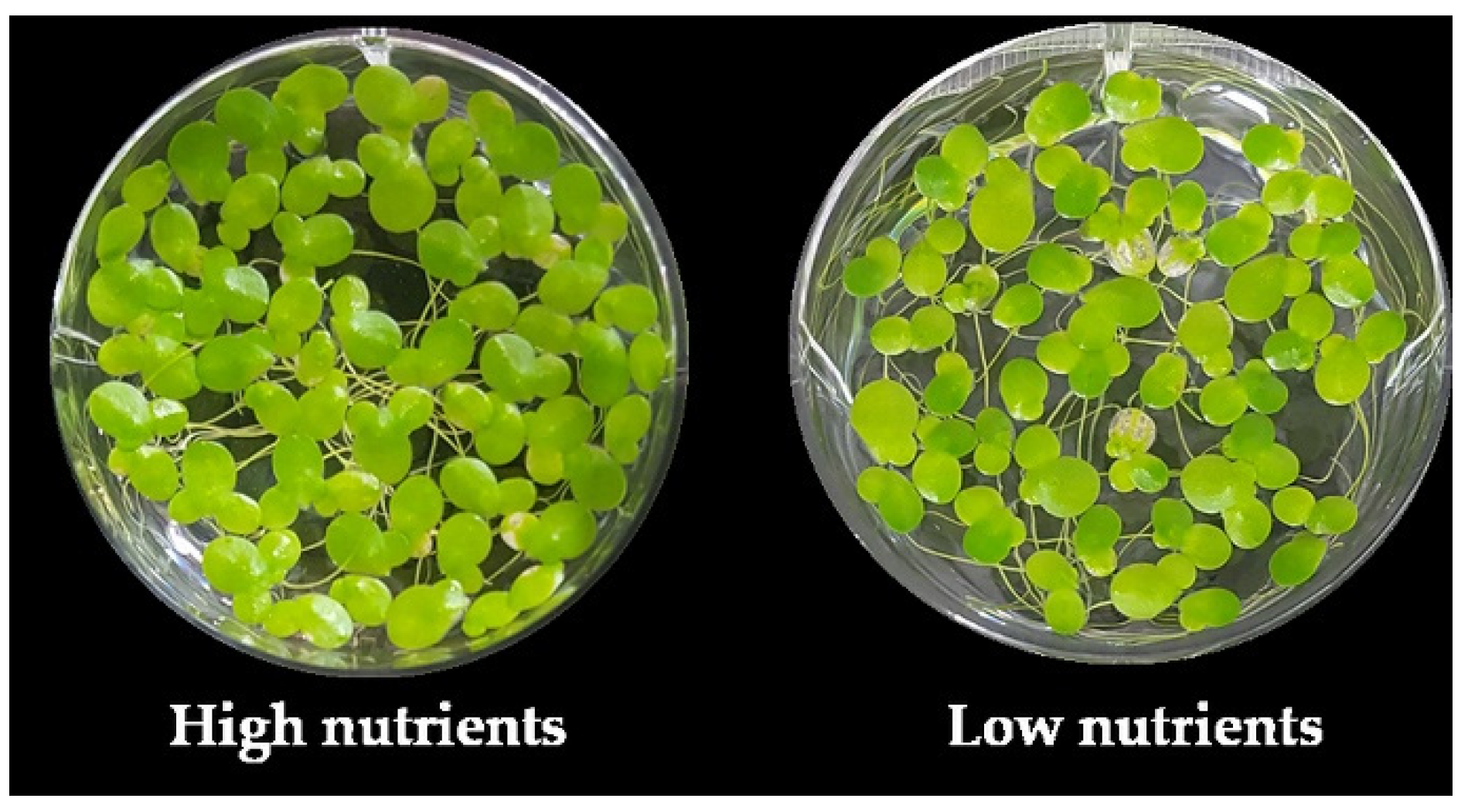
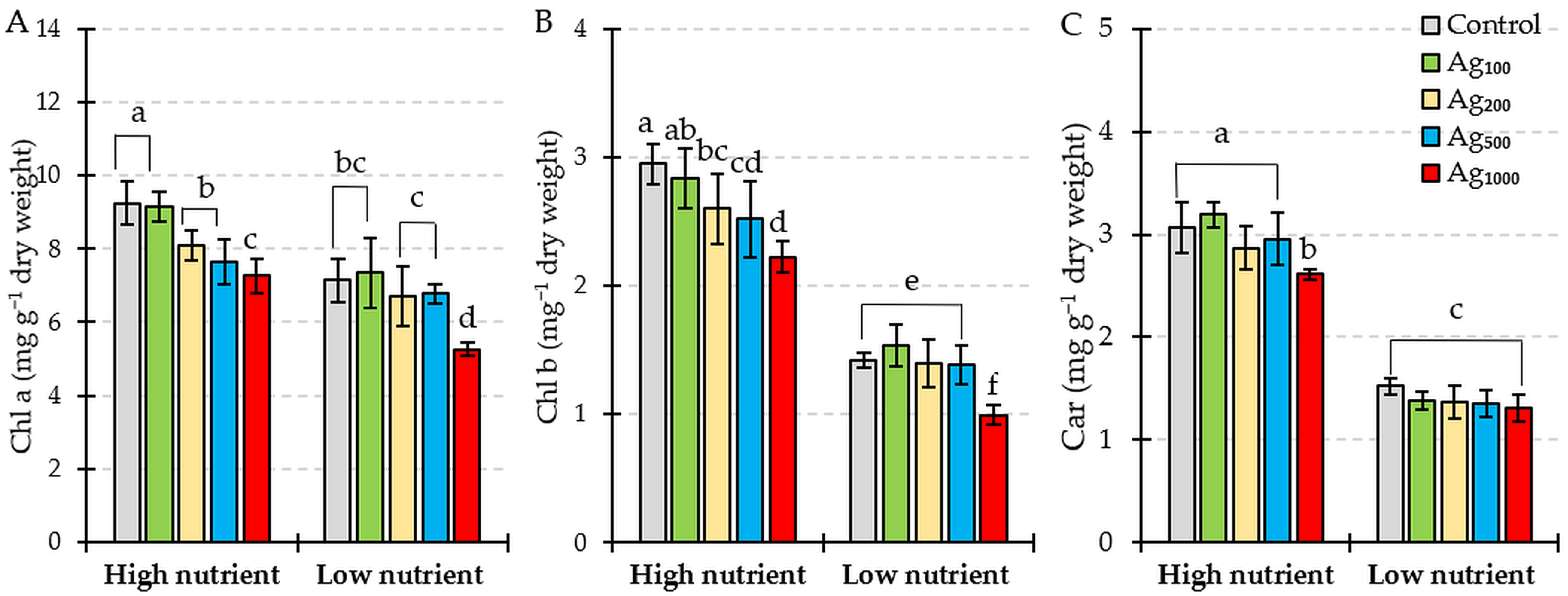
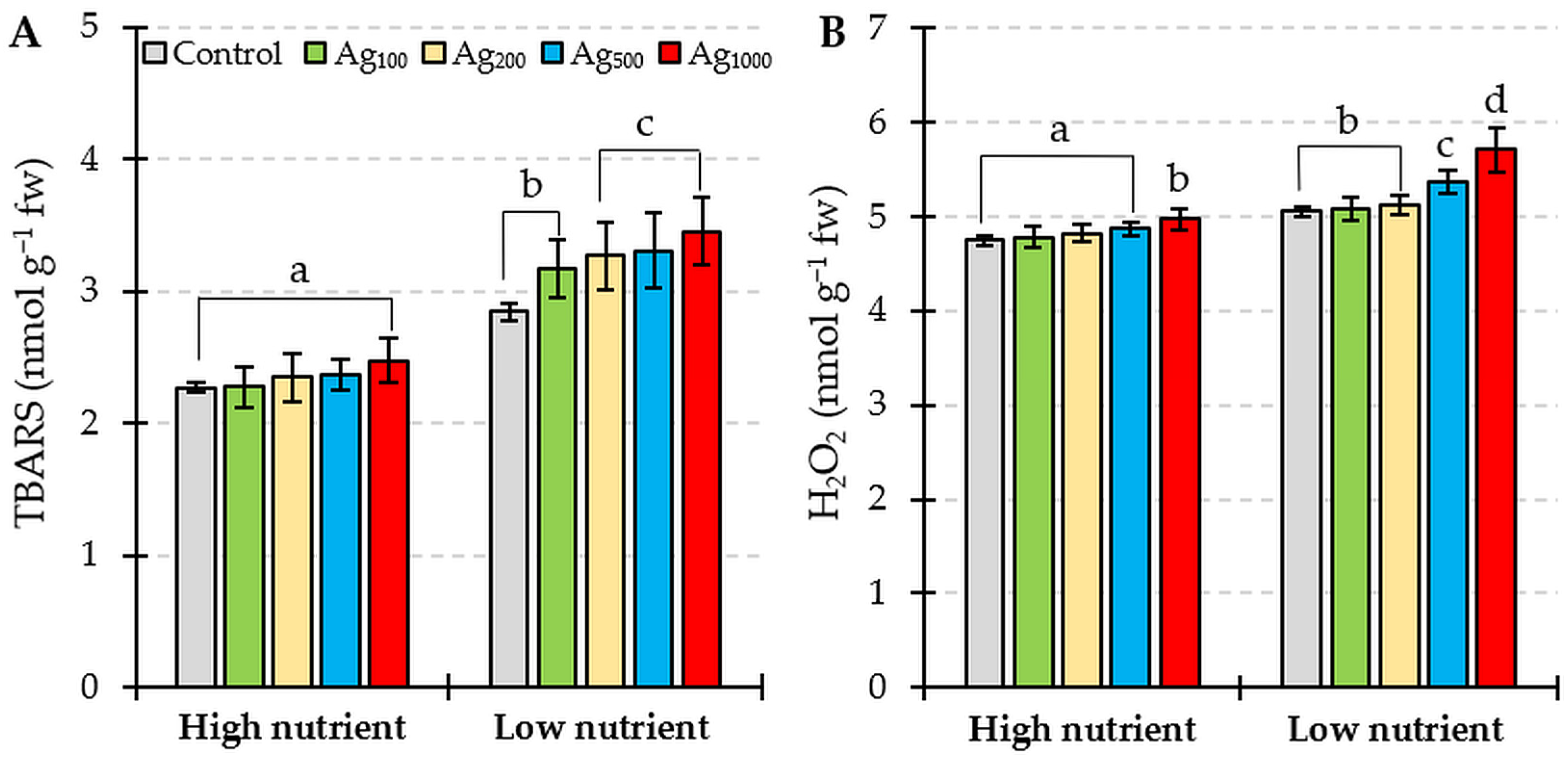
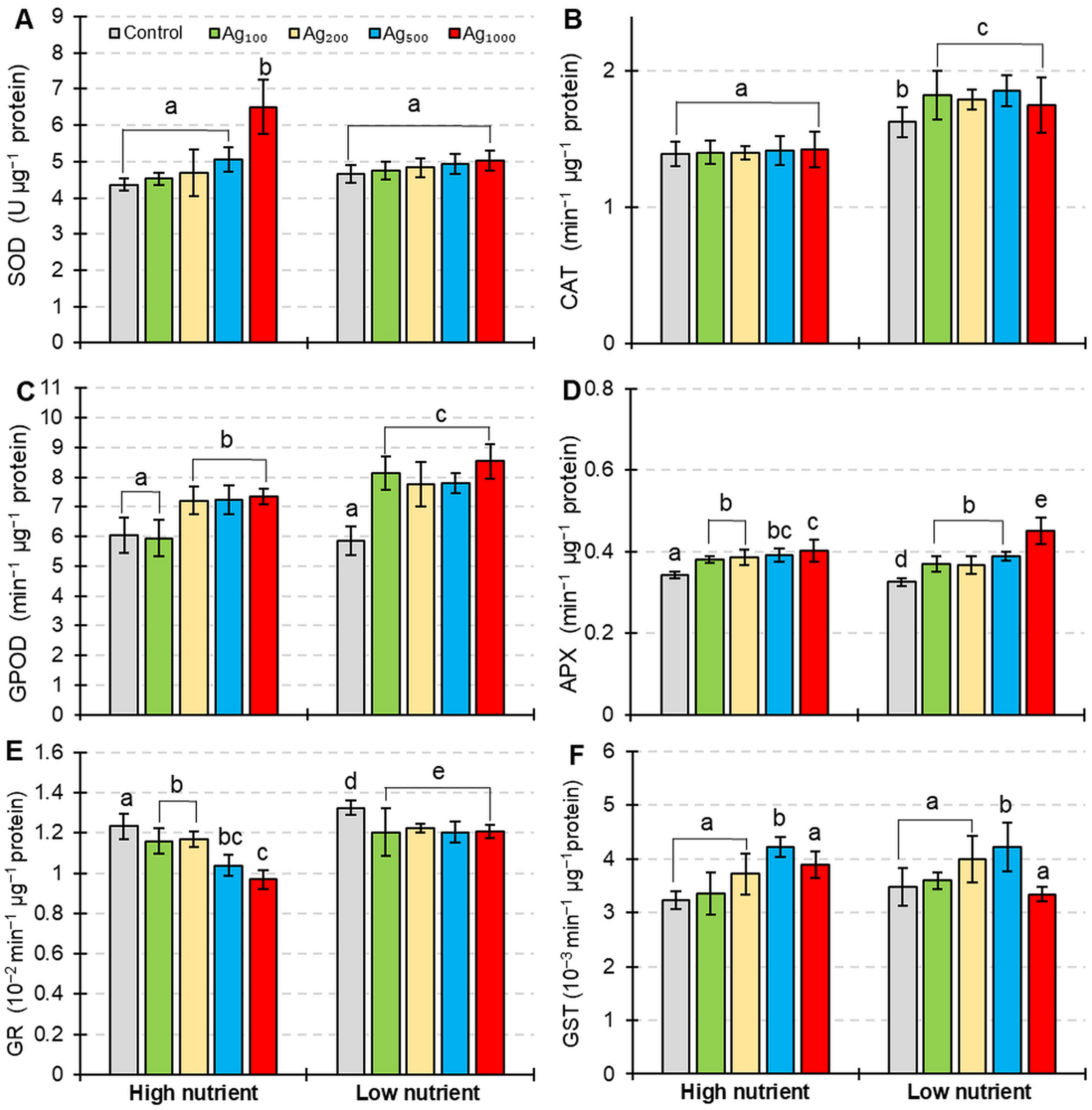
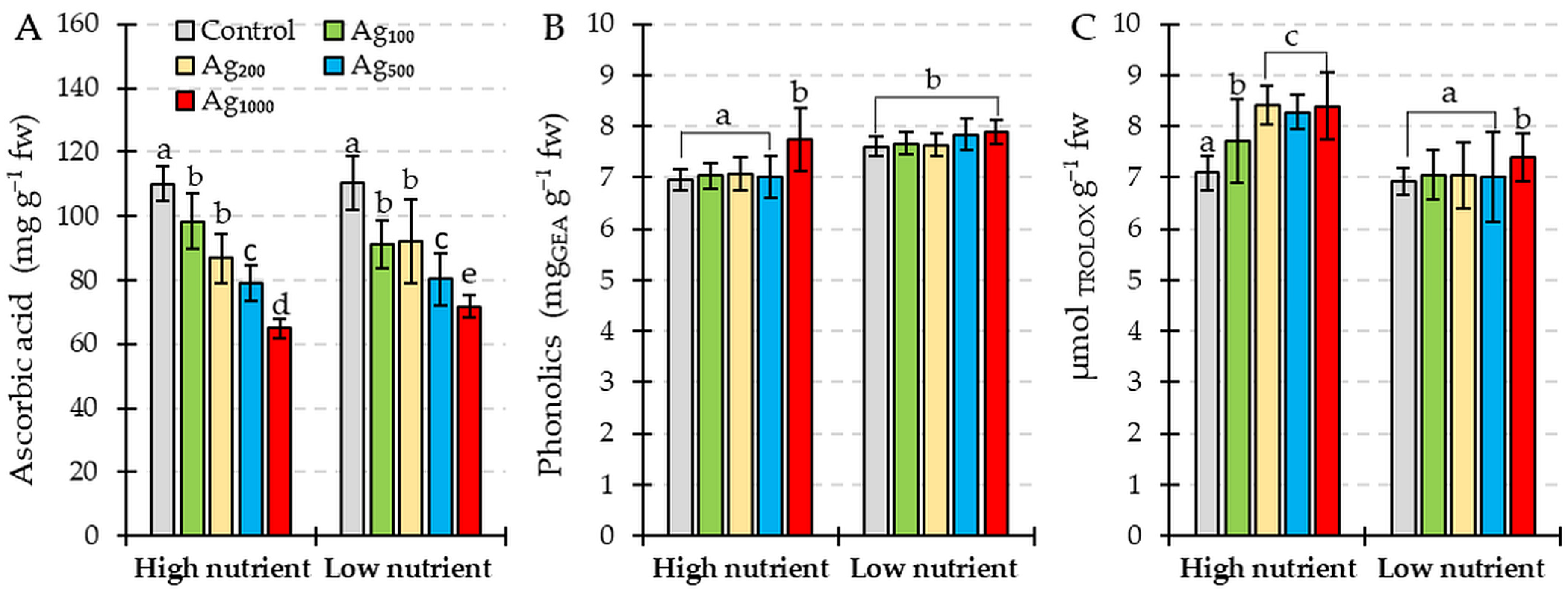
| Frond Number Growth Rate (Day−1) | Doubling Time (Day) | Fresh Weight Growth Rate (Day−1) | |
|---|---|---|---|
| High nutrient | 0.29 ± 0.03 a | 2.40 ± 0.19 a | 0.25 ± 0.03 a |
| Low nutrient | 0.18 ± 0.02 b | 3.81 ± 0.45 b | 0.16 ± 0.02 b |
Disclaimer/Publisher’s Note: The statements, opinions and data contained in all publications are solely those of the individual author(s) and contributor(s) and not of MDPI and/or the editor(s). MDPI and/or the editor(s) disclaim responsibility for any injury to people or property resulting from any ideas, methods, instructions or products referred to in the content. |
© 2023 by the authors. Licensee MDPI, Basel, Switzerland. This article is an open access article distributed under the terms and conditions of the Creative Commons Attribution (CC BY) license (https://creativecommons.org/licenses/by/4.0/).
Share and Cite
Varga, M.; Žuna Pfeiffer, T.; Begović, L.; Mlinarić, S.; Horvatić, J.; Miloloža, T.; Štolfa Čamagajevac, I. Physiological Response of Nutrient-Stressed Lemna gibba to Pulse Colloidal Silver Treatment. Plants 2023, 12, 1367. https://doi.org/10.3390/plants12061367
Varga M, Žuna Pfeiffer T, Begović L, Mlinarić S, Horvatić J, Miloloža T, Štolfa Čamagajevac I. Physiological Response of Nutrient-Stressed Lemna gibba to Pulse Colloidal Silver Treatment. Plants. 2023; 12(6):1367. https://doi.org/10.3390/plants12061367
Chicago/Turabian StyleVarga, Martina, Tanja Žuna Pfeiffer, Lidija Begović, Selma Mlinarić, Janja Horvatić, Tihana Miloloža, and Ivna Štolfa Čamagajevac. 2023. "Physiological Response of Nutrient-Stressed Lemna gibba to Pulse Colloidal Silver Treatment" Plants 12, no. 6: 1367. https://doi.org/10.3390/plants12061367
APA StyleVarga, M., Žuna Pfeiffer, T., Begović, L., Mlinarić, S., Horvatić, J., Miloloža, T., & Štolfa Čamagajevac, I. (2023). Physiological Response of Nutrient-Stressed Lemna gibba to Pulse Colloidal Silver Treatment. Plants, 12(6), 1367. https://doi.org/10.3390/plants12061367






